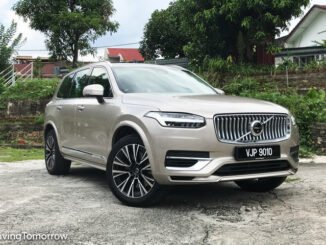
Ingolstadt’s compact executive balances performance and fuel efficiency

Perhaps the all-new A4 looks too much like its predecessor for the “look at my brand new car!” brigade but looking beyond that initial impression, there is a lot that’s brand new in the the A4 2.0 TFSI that makes it a whole new animal from the car before – with superlatives and terms like “class-leading” come up several times.
Although looks-wise, it seems familiar, the all-new Audi A4 has an leaner, sleeker body. Every panel is new. If you put the previous and current cars next to each other, the differences show – the former looks positively chubby. The bolder, more angular grille and stretched proportions make the new car look like it’s been in the gym getting honed. The front and rear lights have also been given the more angular-shape treatment. Its length been extended by 23mm, broadened by 16mm and 12mm has been added between the front and rear wheels to give it the most rear legroom in its class. The increased portions of aluminium and high-strength steel have seen its weight plummet by 120kg.

The MLB 2 platform is also in the latest Q7 and the Bentley Bentayga. Various versions of the EA888 engine are also in the new Audi Q7, Porsche Macan, the Volkswagen Golfs GTI and R and the latest Passat, but none of them have the near-diesel fuel consumption figures claimed: over 20km/litre in the New European Drive Cycle (NEDC), making it the most efficient petrol engine in its class.


This is because besides the weight-loss, the engine has been refined substantially for the A4, including integrating the exhaust manifold into the cylinder head, the rotary-valve model for thermal management, variable valve-lift system for the outlet valves and electric wastegate of the turbocharger. With dual, port and direct, fuel injection, at lower loads, indirect injection in the inlet manifold supplements the direct injection. The Miller-cycle derived rework included altering the valve timings and angles of opening and closing to create shorter, yet higher pressure, compression and longer expansion phases.

The result: the consumption benefits of a smaller engine in partial-load operation, while at higher loads, the advantages of a large-displacement engine. Audi calls it right-sizing. To quote Ulrich Hackenberg, from Audi’s board who oversees technical development, that is “the optimal interplay of vehicle class, displacement, output, torque, and efficiency characteristics under everyday conditions,”.

Unless electrically boosted, most cars tuned for fuel efficiency usually drive well under urban conditions, with lots of low end torque for town traffic nippiness but they lack push at higher speeds for energetic overtaking. That’s the expected trade-off to meet the ever-stringent Euro 6 emissions standards. For Audi, the A4 2.0 TFSI is forecast to be its most popular variant globally and a major contributor to overall corporate carbon accounting so scrimping every gram counts.
Yet the two litre A4 doesn’t feel like a car tuned for efficiency. It had the ability to produce maximum horsepower in a wide range of revolutions under all driving conditions, in both regular and sport modes. The fast responses in Drive and slick changes from the dual-clutch gearbox made the A4 an almost oxymoronic combination of exhilarating yet also relaxing. Sport mode’s slower shifts up and faster shifts down made highway manoeuvres doubtless, quick and smooth. There is less stress when you know you can get past a long line of dawdling cars before a faster car comes up from the rear.


Damping-wise, the dynamic setting kept the car tight on corners but steering responses were a bit too blunted for truly sporty performance . Throwing it into every hairpin bend with abandon would definitely be a no-no but over long distances, it delivered steady returns on throttle input that took the hard work out of highway driving while its reactive handling kept this driver engaged.

The pared down interior was a change from the B8-generation A4. The first few times getting into the A4, it felt disconcertingly too minimalist. Park was now a button in the gear knob, instead of pushing the stick up past Reverse to P. The area above, the centre console, had been decluttered to just two horizontal, separate panels. The upper had the control tabs for climate comfort, the lower, drive select features. There was also more knee room under the steering column because the angle of the bottom panels of the dash.
The MMI controls are now by the gear console, like the A6, with access to all the features also through controls on the steering wheel. Our test unit came with xenon headlights and analogue display meters which is good for those who want a more straightforward set-up, not filled with a distracting amount of tech-wizardry. If you want more like Audi’s signature LED matrix headlights, along with MMI Navigation plus with MMI touch, a configurable virtual cockpit and Audi Connect, there’s the TechPack variant which is another RM25,000.
Don’t be misled, the A4 is a considerable evolution from the car before.
LISA KUOK
AUDI A4 2.0 TFSI
All-round, all-new but you have to be in the driving seat to appreciate it.
![]()
Price RM248,900
Engine 4-cyl, 1984cc, turbo, petrol
Power 190bhp at 4200-6000rpm
Torque 320Nm at 1450-4200rpm
Gearbox 7-spd dual-clutch auto
Kerb weight 1405kg
0-100km/h 7.3sec
Top speed 210km/h
Economy 20.4km/L (claimed)
Rivals BMW 320i, Mercedes-Benz C200




